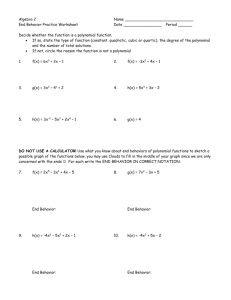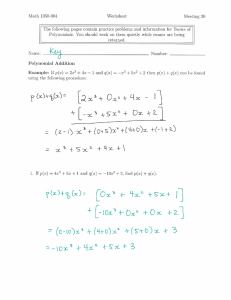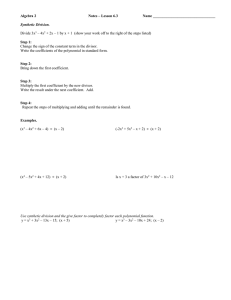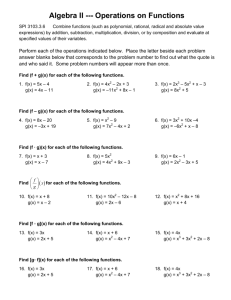Partial Solutions to Homework XI
advertisement
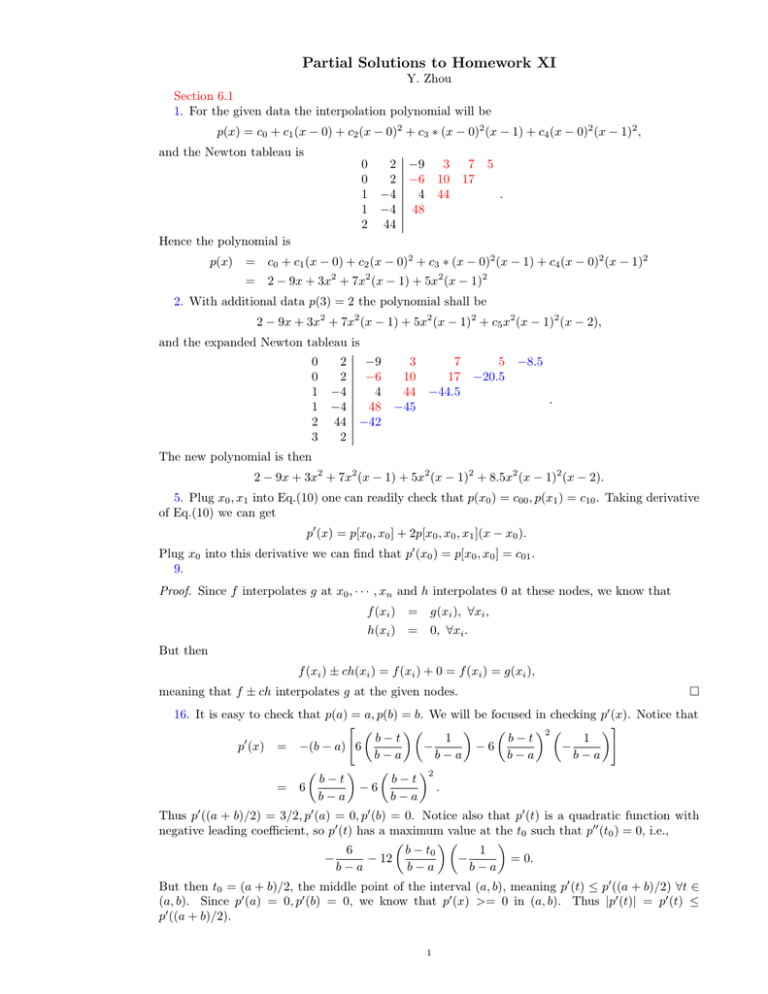
Partial Solutions to Homework XI Y. Zhou Section 6.1 1. For the given data the interpolation polynomial will be p(x) = c0 + c1 (x − 0) + c2 (x − 0)2 + c3 ∗ (x − 0)2 (x − 1) + c4 (x − 0)2 (x − 1)2 , and the Newton tableau is 0 2 −9 0 2 −6 1 −4 4 1 −4 48 2 44 3 10 44 7 17 5 . Hence the polynomial is p(x) = c0 + c1 (x − 0) + c2 (x − 0)2 + c3 ∗ (x − 0)2 (x − 1) + c4 (x − 0)2 (x − 1)2 = 2 − 9x + 3x2 + 7x2 (x − 1) + 5x2 (x − 1)2 2. With additional data p(3) = 2 the polynomial shall be 2 − 9x + 3x2 + 7x2 (x − 1) + 5x2 (x − 1)2 + c5 x2 (x − 1)2 (x − 2), and the expanded Newton tableau is 0 0 1 1 2 3 2 −9 2 −6 −4 4 −4 48 44 −42 2 3 10 44 −45 7 17 −44.5 5 −20.5 −8.5 . The new polynomial is then 2 − 9x + 3x2 + 7x2 (x − 1) + 5x2 (x − 1)2 + 8.5x2 (x − 1)2 (x − 2). 5. Plug x0 , x1 into Eq.(10) one can readily check that p(x0 ) = c00 , p(x1 ) = c10 . Taking derivative of Eq.(10) we can get p0 (x) = p[x0 , x0 ] + 2p[x0 , x0 , x1 ](x − x0 ). Plug x0 into this derivative we can find that p0 (x0 ) = p[x0 , x0 ] = c01 . 9. Proof. Since f interpolates g at x0 , · · · , xn and h interpolates 0 at these nodes, we know that f (xi ) = g(xi ), ∀xi , h(xi ) = 0, ∀xi . But then f (xi ) ± ch(xi ) = f (xi ) + 0 = f (xi ) = g(xi ), meaning that f ± ch interpolates g at the given nodes. 16. It is easy to check that p(a) = a, p(b) = b. We will be focused in checking p0 (x). Notice that " 2 # b−t 1 b−t 1 0 p (x) = −(b − a) 6 − −6 − b−a b−a b−a b−a 2 b−t b−t = 6 −6 . b−a b−a Thus p0 ((a + b)/2) = 3/2, p0 (a) = 0, p0 (b) = 0. Notice also that p0 (t) is a quadratic function with negative leading coefficient, so p0 (t) has a maximum value at the t0 such that p00 (t0 ) = 0, i.e., b − t0 1 6 − 12 − = 0. − b−a b−a b−a But then t0 = (a + b)/2, the middle point of the interval (a, b), meaning p0 (t) ≤ p0 ((a + b)/2) ∀t ∈ (a, b). Since p0 (a) = 0, p0 (b) = 0, we know that p0 (x) >= 0 in (a, b). Thus |p0 (t)| = p0 (t) ≤ p0 ((a + b)/2). 1 2 6.4 1,2. Answers were given in class. 5. f (x) is a quadratic spline function because • f (x) is a polynomial of degree less than or equal to 2 in (−∞, ∞). • f (x) is continuous in (−∞, ∞). This can be check the value of f (x) at the ends of each subintervals. • f 0 (x) is continuous in (−∞, ∞). This can be check the value of 0 f (x) at the ends of each subintervals. 6. Piecewise polynomial f (x) can be a cubic spline function only if • f (x) is a polynomial of degree less than or equal to 3 in (−∞, ∞). • f (x) is continuous in (−∞, ∞). In particular, f (x) must be continuous at the ends of each subintervals. • f 0 (x) is continuous in (−∞, ∞). In particular, f 0 (x) must be continuous at the ends of each subintervals. • f 00 (x) is continuous in (−∞, ∞). In particular, f 00 (x) must be continuous at the ends of each subintervals. By examining these four criterions we get constraints for a, b, c, d, e, i.e., a = c = d 6= 0; b 6= 0 or e 6= 0. Since f (1) = 7, we know c = a = 7. Furthermore, from f (0) = 26 we get b = 2 and from f (4) = 25, we get e = −3.

